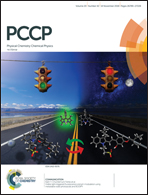Reduction of thermal conductivity in silicene nanomesh: insights from coherent and incoherent phonon transport†
Abstract
Silicene nanomesh (SNM), a silicene sheet with periodically arranged nanoholes, has gained increasing interest due to its unique geometry and novel properties. In this paper, we have conducted molecular dynamics simulations to study the phonon transport properties of SNMs. The results demonstrate that the thermal conductivity of SNM, which is shown to be much lower than that of silicene, is little affected by temperature but can be effectively tuned by varying the porosity. To elucidate the underlying mechanisms for decreased thermal conductivity, we have investigated both coherent and incoherent phonon transport in SNMs. It is found that the phonon backscattering at the nanopore edges leads to extra thermal resistances. Additionally, the introduction of nanopores induces phonon localization and consequently hinders phonon transport in SNMs. The phonons of SNM exhibit coherent resonant behavior, which is believed to reduce the phonon group velocities and thus leads to a further reduction in thermal conductivity of SNMs. Our findings could be useful in the design of thermal properties of silicene for applications in thermoelectrics, thermal insulation and thermal protection.



 Please wait while we load your content...
Please wait while we load your content...